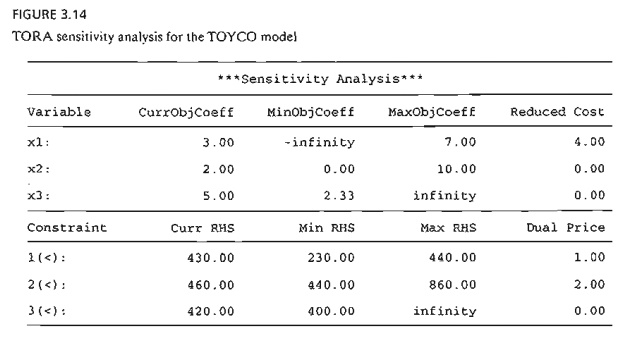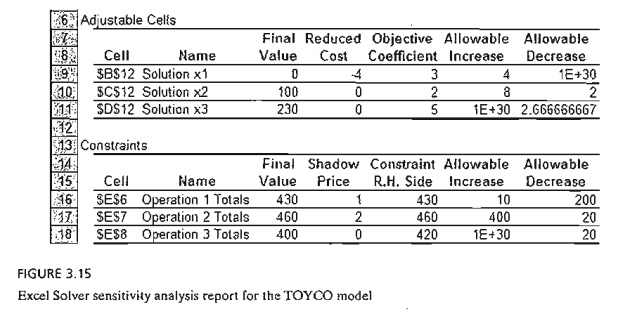Chapter: Operations Research: An Introduction : The Simplex Method and Sensitivity Analysis
Sensitivity Analysis with TORA, Solver, and AMPL
Sensitivity Analysis with TORA, Solver, and AMPL
We now
have all the tools needed to decipher the output provided by LP software,
particularly with regard to sensitivity analysis. We will use the TOYCO
example to demon-strate the TORA, Solver, and AMPL output.
TORA's LP
output report provides the sensitivity analysis data automatically as shown in
Figure 3.14 (file toraTOYCO.txt). The output includes the reduced costs and the
dual prices as well as their allowable optimality and feasibility ranges.



Figure
3.15 provides the Solver TOYCO model (file solverTOYCo.xls) and its sensitivity
analysis report. After you click Solve in the Solvcr Parameters dialogue box,
the new dialogue box Solver Rcsults will give you the opportunity to request
further details about the solution, including the important sensitivity
analysis report. The re-port will be stored in a separate Excel sheet, as shown
by the choices on the bottom of the screen. You can then click Sensitivity
Report 1 to view the results. The report
is similar to TORA's with three exceptions: (1) The reduced cost carries an
opposite sign. (2) The name shadow price
replaces the name du.al price. (3)
The optimality ranges are for the changes dj
and Dj rather than for the total
objective coefficients and constraints on the right-hand side. The differences
are minor and the interpretation of the results remains the same.
In AMPL,
the sensitivity analysis report is readily available. File amplTOYCo.txt
provides the code necessary to determine the sensitivity analysis output. It
requires the following additional statements:

The CPLEX
option statements are needed to be able to obtain the standard sen-sitivity
analysis report. In the TOYCO model, the indexed variables and constraints use
the root names x and oper, respectively. Using these names, the suggestive
suffixes . down, . current, and. up in the display statements automatically
generate the for-matted sensitivity analysis report in Figure 3.16. The
suffixes . dual and. rc provide the dual price and the reduced cost.
An
alternative to AMPL's standard sensitivity analysis report is to actually solve
the LP model for a range of values for the objective coefficients and the
right-hand side of the constraints. AMPL automates this process through the use
of commands (see Section A.7). Suppose in the TOYCO model, file amplTOYCo.txt,
that we want to in-vestigate the effect of making changes in b [1] , the total available time for
operation 1. We can
do so by moving solve and display from amplTOYCO.txt to a new file, which we
arbitrarily name analysis. txt:

The first
line will provide the model and its data and the second line will provide the
optimum solutions starting with b [II at 430 (the initial value given in
amplTOYCO.txt) and continuing in increments of 1 until b [1] reaches 500. An examination of
the out-put will then allow us to study the sensitivity of the optimum solution
to changes in b [1] Similar procedures can be
followed with other coefficients including the case of making simultaneous changes.
PROBLEM SET 3.6E
1. Consider
Problem 1, Set 2.3c (Chapter 2). Use the dual price to decide if it is
worthwhile to increase the funding for year 4.
2. Consider
Problem 2, Set 2.3c (Chapter 2).
a.
Use the dual prices to determine the overall return
on investment.
b.
If you wish
to spend $1000 on pleasure at the end of year 1, how would this affect the accumulated amount at the
start of year 5?
1. Consider
Problem 3, Set 2.3c (Chapter 2).
a. Give an
economic interpretation of the dual prices of the model.
b. Show how
the dual price associated with the upper bound on borrowed money at the
beginning of the third quarter can be derived from the dual prices associated
with the balance equations representing the in-out cash flow at the five
designated dates of the year.
2. Consider
Problem 4, Set 2.3c (Chapter 2). Use the dual prices to determine the rate of
re-turn associated with each year.
*5.
Consider Problem 5, Set 2.3c (Chapter 2). Use the dual price to determine if it
is worth-while for the executive to invest more money in the plans.
6. Consider
Problem 6, Set 2.3c (Chapter 2). Use the dual price to decide if it is
advisable for the gambler to bet additional money.
7. Consider
Problem 1, Set 2.3d (Chapter 2). Relate the dual prices to the unit production
costs of the model.
8. Consider
Problem 2, Set 2.3d (Chapter 2). Suppose that any additional capacity of
ma-chines 1 and 2 can be acquired only by using overtime. What is the maximum
cost per hour the company should be willing to incur for either machine?
*9. Consider Problem 3, Set 2.3d (Chapter 2).
a. Suppose
that the manufacturer can purchase additional units of raw material A at $12
per unit. Would it be advisable to do so?
b. Would you
recommend that the manufacturer purchase additional units of raw ma-terial B at $5 per unit?
10. Consider
Problem 10, Set 2.3e (Chapter 2).
a) Which of
the specification constraints impacts the optimum solution adversely?
b) What is
the most the company should pay per ton of each ore?
Related Topics